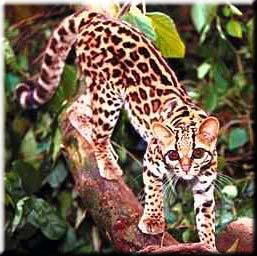About
Many people think of tigers when they hear the word “bengal”, but in this case the name stems from the latin for the ‘Asian Leopard Cat, Felis Bengalensis’, a small forest dwelling cat found throughout Asia.
The Asian Leopard Cat is not restricted to Asia as its name may lead you to think. It can be found in Southern India and eastward through Thailand, Malaysia, China and the Soviet Far East. It is found on many islands such as Sumatra, Philippines, Taiwan, Borneo, Bali and Java. As a result of this wide range in its habitat it is known by many different names. A few you may see or hear are:
- The Java Cat
- Wagati Cat
- Chinese Cat
- Money Cat (the spots resemble Chinese coins)
The Bengal originated with a cross mating between the Asian Leopard Cat and the domestic cat. This hybrid was then developed in the United States by Jean Mill of Millwood fame, Southern California and first documented in 1963. Jean’s efforts resulted in a domestic Bengal house pet resembling the physical attributes and beauty of the Asian Leopard Cat. Others who believed in the breed joined in the efforts to further develop this wonderful cat giving us our domestic ‘living room leopards’ with the ever developing beauty of their wild ancestory.


Only in recent years has a breed of domestic cat been developed to resemble the exquisitely spotted African leopard. The closest you can come to owning a big jungle cat! The Bengal is a relatively young breed which has gained immensely in popularity and is the most talked about cat of its kind in the pet world. An excellent choice for families with children, Bengals are alert, incredibly athletic and entertaining, sweet-tempered, and eager for human companionship. These lovely family pets are charming the cat fancy and pet owners alike.
It is difficult to fully convey the delight of owning a Bengal cat! They are so intelligent and responsive that they become adored family members almost at once. The beauty is what first attracts cat lovers to the breed, but it is the personality that makes them enthusiasts.
Today’s Bengal may be similar in appearance to the Asian Leopard Cat, and its genetic makeup may contain contributions from that wild cat species, but the temperament is that of an affectionate and loving cat that will be a pleasant and trustworthy family companion. Bengals are self-assured, affectionate, and playful, with the stunning looks of their wild ancestor.
Purrsonality
Extremely intelligent. Bengals are alert to anything new in the immediate environment and are curious to learn. When groceries are brought into the home, the Bengal insists on looking and sometimes getting into the grocery bags. They follow their humans from room to room always to be near and sometimes upon the awaited lap. Some individuals are quite headstrong as to their likes and dislikes, much like any domestic cat and may prefer not to be picked up. They may squirm to get down, and then jump into that same lap at their own discretion. Like other cats, Bengals prefer affection on their own terms. Eager for human companionship and approval, this is a breed that can be taught the rules of the house (such as to stay off tables and kitchen sinks) with only a minimum of training. A sharp “no”, will make the rule clear. Responding to kindness they quickly observe what annoys their humans and will avoid the negative response.


Bengals are natural retrievers of soft balls, crumpled bits of newspaper, or cat toys.
Most Bengals enjoy water and will play for long periods in a bathroom sink with the tap slightly running. Our Thistle loves sitting on the edge of her washing machine watching the water trickle into the machine. The cat’s antics will delight children and adults alike. Bengals love attention and will welcome it from adults and children alike.
A Bengal is a wise choice for people with allergies, for the sleek, soft coat seems to hold fewer allergens. It is a different type of fur; more like a pelt than ordinary cat fur, and sufferers of allergies claim that they can tolerate close facial contact with Bengals with fewer reactions.
It is difficult to fully convey the delight of owning a Bengal cat! They are so intelligent and responsive that they become adored family members almost at once. The beauty is what first attracts cat lovers to the breed, but it is the personality that makes them enthusiasts.

